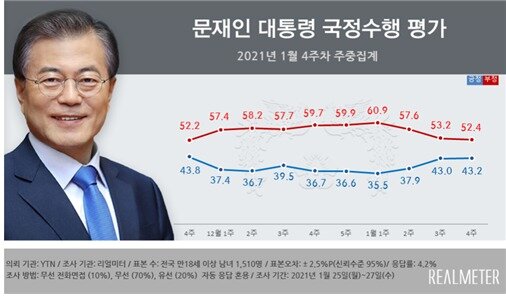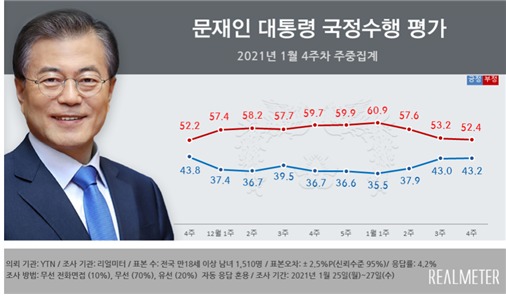 |
| (Photo provided by Real Meter) © News 1 |
President Moon Jae-in’s approval rate for state administration was on the rise, maintaining the 40% level for the second consecutive week.
The results of a weekly interim count survey for the 4th week of January announced on the 28th, conducted by Real Meter, a public opinion poll specialist, on 1510 voters aged 18 and over nationwide from the 25th to the 27th. It was 43.2%, up 0.2 percentage points (p). ‘Very good’ was 24.6%, and’well done’ was 18.6%.
The negative evaluation was 52.4%, down 0.8%p over the same period. 15.2% of those who are’wrong’ and 37.2% of’very wrong’. ‘Don’t know/no answer’ increased 0.8%p to 4.5%.
The gap between positive and negative evaluations is 9.2%p, which is outside the margin of error, and is narrowing this month. The positive rating from 35.5% in the first week of January is rising to 37.9% in the second week and 43.0% in the third week. During the same period, negative valuation fell from 60.9% to 57.6% and 53.2%.
Daily indicators of positive evaluation showed a trend of 44.2% (51.7% of negative evaluation) on the 25th, 40.8% (54.5%) on the 26th, and 43.1% (52.5%) on the 27th.
For positive evaluation by region, Seoul (6.8%p↑, 37.7%→44.5%, negative evaluation 50.8%), Daegu and Gyeongbuk (5.7%↑, 25.3%→31.0%, 64.2%), Daejeon, Sejong, and Chungcheong (3.2%) p↑, 36.1%→39.3%, 57.9%), while Gwangju and Jeolla (10.5%p↓, 70.0%→59.5%, 34.9%), Busan, Ulsan, Gyeongnam (1.9%p↓, 42.1%→40.2) %, 56.2%).
By gender, women (2.0%p↑, 45.7%→47.7%, 47.2%) increased, and men (1.7%p↓, 40.3%→38.6%, 57.6%) decreased.
By age group, it increased from those in their 20s (9.0%p↑, 34.3%→43.3%, 47.3%), 70s and older (3.1%p↑, 34.4%→37.5%, 57.2%) and 30s (4.0%p↓, 48.3%) %→44.3%, 51.8%), 60s (3.5%p↓, 38.6%→35.1%, 61.7%), 40s (2.4%p↓, 52.8%→50.4%, 46.8%), 50s (1.4% p↓, 46.6%→45.2%, 52.5%).
By party support, shaman (4.5%p↑, 15.6%→20.1%, 63.0%) rose up, while Democratic party supporters (3.3%p↓, 90.3%→87.0%, 10.6%), Justice party supporters (1.1%p↓, It fell from 40.6% → 39.5%, 56.5%). By ideological orientation, the progressive group (5.4%p↑, 71.7%→77.1%, 20.1%) and the middle class (1.9%p↑, 39.4%→41.3%, 55.1%) increased, and the conservative group (3.6%p↓, 23.4%→) 19.8%, 77.6%).
By occupation, students (14.7%p↑, 28.5%→43.2%, 49.0%) and housewives (3.7%p↑, 38.6%→42.3%, 53.4%) increased. Self-employed (2.8%p↓, 39.5%→36.7%, 60.4%), white collar workers (1.8%p↓, 53.7%→51.9%, 46.1%), labor workers (1.6%p↓, 45.3%→43.7%, 51.3%) Fell in.
On the other hand, this survey is based on a wireless phone interview (10%), wireless (70%), wireline (20%) automatic answering method, and wireless phone (80%) and landline phone (20%). Conducted by hanging method. Statistical corrections were made in a method of assigning rim weights by gender, age group, and district based on the resident registration demographic statistics of the Ministry of Public Administration and Security at the end of October 2020. The sample error is ±2.5%p at the 95% confidence level, and the response rate is 4.2%.
Detailed survey summary and results can be viewed on the website of the Real Meter or the Central Election Polls Review Committee.
